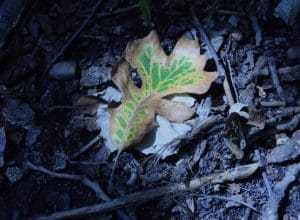For the past two years, I have intermittently spent time exploring the Catherine Chevalier Forest Preserve in Chicago. While I've enjoyed the practice of forest bathing - a traditional practice in Japan called shinrin-yoku - I have begun to gather and collect what I've discovered on the forest floor: leaves, acorns, pieces of bark and florescence. To help put names to what I've found, and a better idea of what I've experienced in the woods, I've turned to some books for guidance.
The Book of Leaves offers clear, detailed and true-to-life color photographs of leaves to visually match your findings. With over 600 pages of text, each leaf is described by Latin and English names, geographical background and other scientific characteristics. The authors also share some of each tree's use-value, such as the white oak's appropriate physicality for the creation of whiskey barrels.
The Naming of Names contains a comprehensive literary history of plants alongside illuminating, ornate illustrations that date back to the 5th century. This book of observative accounts and anecdotes from writers such as Albertus Magnus is perfect for understanding how plants have been revered as sacred and applied medicinally throughout human civilization.
Tree is a nonfiction account of a single, centuries-old Douglas fir. The narrative focuses on one particular tree growing on the West Coast of North America, yet shows how this tree serves as an example of the interconnectedness of biological life throughout space and time, subject to the changes, whims and mysterious movement of nature.
Vanishing Flora features beautiful illustrations of plants that are endangered around the globe, allowing for a greater appreciation of the diverse life around us. Each image is supplemented with bite-sized captions full of details: reasons why the plant is threatened, current and past locations, suggestions for protection and more.
As flora begins to blossom in the spring, our eyes catch colors, textures and form more astutely. To become more familiar with some of Illinois' most prominent wildflowers, a good guidebook can be helpful. Wildflowers of Illinois Woodlands provides geographical, scientific and historical background for growths like the anemone, geranium, cattail and many more, also sharing their cultural significance.




Add a comment to: The Histories and Names of Trees & Flora